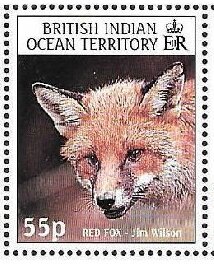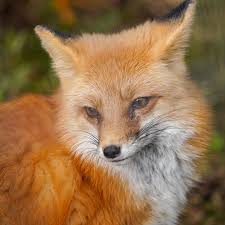Stamp: Red fox bu Jim Wilson (British Indian Ocean Territory 2000)
Red fox bu Jim Wilson (British Indian Ocean Territory 2000)
22 May (British Indian Ocean Territory ) within release The Stamp Show 2000 London - Fauna goes into circulation Stamp Red fox bu Jim Wilson face value 55 British penny
| Stamp Red fox bu Jim Wilson in catalogues | |
|---|---|
| Michel: | Mi: IO 245 |
| Stamp Number: | Sn: IO 218c |
Stamp is square format.
Stamp from souvenir sheetAlso in the issue The Stamp Show 2000 London - Fauna:
- Souvenir Sheet - The Stamp Show 2000 London - Fauna face value 2.15;
- Stamp - Red fox bu Jim Wilson face value 55;
- Stamp - Puffin by P. J. Royal face value 34;
- Stamp - Robin, by Harry Smith face value 1;
- Stamp - Field vole by Colin Sargent face value 26;
Stamp Red fox bu Jim Wilson it reflects the thematic directions:
Animals are multicellular, eukaryotic organisms of the kingdom Animalia (also called Metazoa). All animals are motile, meaning they can move spontaneously and independently, at some point in their lives. Their body plan eventually becomes fixed as they develop, although some undergo a process of metamorphosis later on in their lives. All animals are heterotrophs: they must ingest other organisms or their products for sustenance.
Foxes are small-to-medium-sized omnivorous mammals belonging to several genera of the family Canidae. They have a flattened skull; upright, triangular ears; a pointed, slightly upturned snout; and a long, bushy tail ("brush").
Mammals are any vertebrates within the class Mammalia (/məˈmeɪli.ə/ from Latin mamma "breast"), a clade of endothermic amniotes distinguished from reptiles (including birds) by the possession of a neocortex (a region of the brain), hair, three middle ear bones and mammary glands. All female mammals nurse their young with milk, secreted from the mammary glands. Mammals include the largest animals on the planet, the great whales. The basic body type is a terrestrial quadruped, but some mammals are adapted for life at sea, in the air, in trees, underground or on two legs. The largest group of mammals, the placentals, have a placenta, which enables the feeding of the fetus during gestation. Mammals range in size from the 30–40 mm (1.2–1.6 in) bumblebee bat to the 30-meter (98 ft) blue whale. With the exception of the five species of monotreme (egg-laying mammals), all modern mammals give birth to live young. Most mammals, including the six most species-rich orders, belong to the placental group. The largest orders are the rodents, bats and Soricomorpha (shrews and allies). The next three biggest orders, depending on the biological classification scheme used, are the Primates (apes and monkeys), the Cetartiodactyla (whales and even-toed ungulates), and the Carnivora (cats, dogs, seals, and allies).
Photography is the art, application, and practice of creating images by recording light, either electronically by means of an image sensor, or chemically by means of a light-sensitive material such as photographic film. It is employed in many fields of science, manufacturing (e.g., photolithography), and business, as well as its more direct uses for art, film and video production, recreational purposes, hobby, and mass communication. A person who captures or takes photographs is called a photographer.




